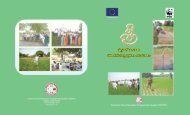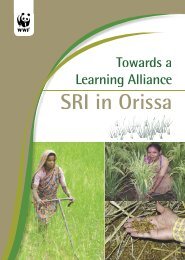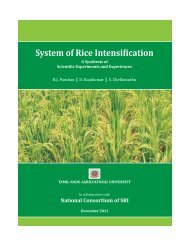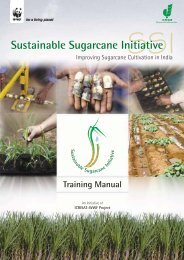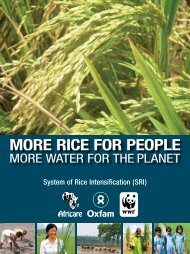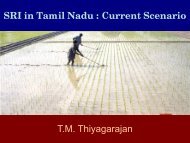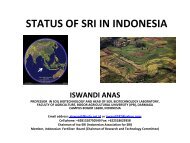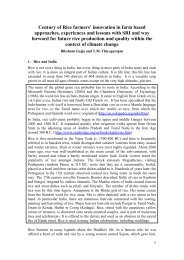SSI Newsletter - SRI - India
SSI Newsletter - SRI - India
SSI Newsletter - SRI - India
Create successful ePaper yourself
Turn your PDF publications into a flip-book with our unique Google optimized e-Paper software.
Malagasy rice farmers in Madagascar<br />
(ANN, ciifad.cornell.edu). He came up<br />
with the idea of <strong>SRI</strong> in 1983. In 1990, Fr<br />
De Laulanie, along with some Malagasy<br />
colleagues set up a non-government<br />
organization, NGO, the Association<br />
Tefy Saina, to help improve lives in<br />
Madagascar. ‘Tefy Saina’ means, in<br />
Malagasy, ‘to improve the mind.’<br />
Cornell International Institute for Food,<br />
Agriculture and Development, is now<br />
working with Tefy Saina. The Jesuits<br />
can teach even the experts a thing or<br />
two about culture and agriculture.<br />
From <strong>SRI</strong> to <strong>SSI</strong>. The <strong>SSI</strong> approach has<br />
been tested by farmers in different<br />
climatic zones of <strong>India</strong>: Punjab, Uttar<br />
Pradesh, Andhra Pradesh, Karnataka<br />
and Orissa (KV Kumanath, 07 May,<br />
thehindubusinessline.com). With<br />
very encouraging results, Gujja says<br />
he expects that the <strong>SSI</strong> practice will<br />
replace farmer’s practice in sugarcane<br />
within 5 years (FnBnews, sucreethique.org).<br />
I expect the same for<br />
the Philippines.<br />
In fact, <strong>SSI</strong> is the new economics of<br />
agriculture – neo-agriculture I shall<br />
call it from here on, because it’s new<br />
and because I believe the concepts<br />
are applicable with other crops. This is<br />
the Sweet Revolution of 2009 I refer<br />
to in the title to this essay.<br />
Call it <strong>SSI</strong> or call it neo-agriculture, it<br />
has been shown to work in practice,<br />
not simply in theory. One <strong>India</strong>n farmer,<br />
PK Singh, in Uttar Pradesh found that<br />
cane yields went up to 100 tonnes to<br />
a hectare as against a ‘normal’ yield of<br />
30 tonnes (ANN, 06 May, expressbuzz.<br />
com). That’s an increase in yield of<br />
more than 3 times.<br />
From the training manual, the first<br />
recommendation that caught my eye<br />
is that on water. If you follow neoagriculture,<br />
all things being equal, your<br />
input will be up to 80% less water for<br />
irrigation and your output will be up<br />
to 50% more cane for sugar. The new<br />
economics of agriculture. Why didn’t<br />
pre-climate change agriculturists<br />
think of that?! They couldn’t have<br />
because they were not thinking out<br />
of the box. Now, neo-agriculturists, as<br />
well as neo-economists perforce must<br />
think of water used in production, not<br />
as a dependent but an independent<br />
variable, something that can be to<br />
the highest degree manipulated,<br />
controlled, varied or changed. This is<br />
water before the bridge.<br />
The ICRISAT-WWF sugarcane scientists<br />
may have been thinking more of <strong>India</strong>n<br />
sugarcane farmers than those in other<br />
lands, but that was natural. They had<br />
enough problems in <strong>India</strong> already! Neoagriculture<br />
will have greater impact<br />
in <strong>India</strong> than the Philippines, simply<br />
because in the Land of the Maharajas,<br />
there are 36 million sugarcane<br />
farmers, and that number is more<br />
than the entire population of Canada,<br />
estimated at 32 million in 2006, 35<br />
million in 2021 (sustreport.org). This<br />
is not to mention the multiplier effect<br />
in <strong>India</strong> on another 50 million who<br />
depend on employment generated by<br />
the 571 sugar factories and industries<br />
using sugar.<br />
It is true that we have only 56,000<br />
Filipino sugarcane farmers (Katharine<br />
Adraneda, 2007, newsflash.org), but<br />
even then, all of them too have to<br />
practice neo-agriculture for cane<br />
starting right now. Filipinos, neofarmers<br />
of sugarcane? That would be<br />
sweet music to my ears.<br />
For starters, here are some techniques<br />
In fact, <strong>SSI</strong> is the new<br />
economics of agriculture<br />
– neo-agriculture I shall<br />
call it from here on,<br />
because it’s new and<br />
because I believe the<br />
concepts are applicable<br />
with other crops. This is<br />
the Sweet Revolution of<br />
2009 I refer to in the<br />
prescribed for <strong>SSI</strong>/neo-agriculture<br />
for sugarcane (mostly from the <strong>SSI</strong><br />
training manual):<br />
(1) Raise single-budded setts in nursery.<br />
Grow the setts in trays filled with<br />
coconut coir. Being hygroscopic,<br />
the coir absorbs water 8-9 times its<br />
own weight, then slowly releases<br />
the precious liquid to the feeding<br />
roots of the setts. Also, nurseryraised<br />
settlings are excellent for<br />
filling up missing hills at anytime<br />
– the nursery settlings are of the<br />
same age as the ones growing in<br />
the field. They will mature at the<br />
same time.<br />
(2) Transplant young settlings (25-35<br />
days old). By then, the settlings<br />
are old enough and vigorous<br />
to withstand the shock of<br />
transplanting. Well-developed, the<br />
setts can compete with the weeds<br />
better, and can increase cane yield<br />
by up to 85% (Yukio Ishimine et al,<br />
1994, University of the Ryukyus,<br />
rms1.agsearch.agropedia.affrc.<br />
go.jp).<br />
(3) Space widely (5x2 feet) in main<br />
field. Rather than at1.5x2.5 ft,<br />
plant at 5x2 ft. This will result in 2<br />
times more millable canes because<br />
the setts produce more tillers. It<br />
also reduces the number of setts<br />
needed from 16,000 3-budded<br />
setts to 4,000 single-budded setts<br />
to an acre.<br />
(4) Apply a trash mulch. Apply<br />
sugarcane trash within 3 days<br />
of planting. Mulching is the best<br />
practice in controlling weeds.<br />
Trash mulch can also increase<br />
yield and decrease energy cost (AC<br />
Srivastava, 2002, asae.frymulti.<br />
com). I myself have written about<br />
what Edward H Faulkner calls<br />
trash farming in my ‘Lesson of<br />
the Water Cycle’ (20 April 2008,<br />
americanchronicle.com).<br />
title to this essay. (Contd. on page 14)<br />
Nov ‘09<br />
9<br />
SugarCane<br />
matters



